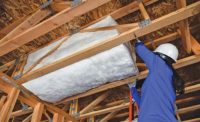XPS and polyiso can address moisture concerns within exterior walls—especially in cold or wet climates. They ultimately reduce, and in some cases eliminate, the need for additional materials.
In residential housing design, rigid foam sheathing often goes overlooked as an important aspect of continuous insulation. Yet as the International Code Council and other groups set stricter energy efficiency requirements, exterior insulation will become a more crucial component of an energy efficient and sustainable home.
To ensure compliance with higher code standards—now and as standards continue to evolve—savvy contractors and builders should understand the various roles rigid foam sheathing plays in an integrated wall system.
For residential construction, there are two primary types of foam sheathing: thermoplastics and thermosets. Expanded polystyrene and extruded polystyrene are thermoplastics, while polyisocyanurate (polyiso) is a thermoset.
Across the board, any of these products added to the exterior wall assembly will provide a layer of continuous insulation needed to prevent thermal bridging that can drastically decrease the energy efficiency of the entire wall system. While all three materials provide varying degrees of added energy efficiency, contractors should also consider the long-term R-value, water vapor permeance, ease of installation and overall cost when selecting materials. The differences lie in these details.
R-VALUE
The R-value of the product types represents a good, better, best scenario: EPS has an R-value of approximately R-4 per inch, followed closely by XPS (R-5 per inch). At 6.5 per inch, polyiso foam has the highest R-value per inch of the three sheathing products.
It’s also important to note that polyiso and XPS slowly lose R-value over time. However, polyiso is rated on a weighted 15-year Long Term Thermal Resistance value (LTTR). While an R-value of 6.5 per inch makes polyiso one of the most thermally efficient insulations on the market, there are options to reduce this gradual reduction of thermal effectiveness. For example, a foil-faced product helps maintain long-term R-value by helping keep the thermally resistant blowing agent from leaking out and air getting in.
PERMEANCE
Permeance—or the degree to which a material transfers water vapor—is another important consideration. Rigid foam sheathing plays an important role in the overall wall system and can help address moisture problems caused by rainwater, vapor and condensation.
Material permeance is broken into four primary categories: 1) Vapor impermeable (0.1 perms or fewer, considered a Class I vapor retarder); 2) Vapor semi-impermeable (1.0 perms or fewer, considered a Class II vapor retarder); 3) Vapor semi-permeable (10 perms or fewer, a Class III vapor retarder), 4) Vapor permeable have a greater than 10 perms and are not vapor retarders. Manufacturing differences, thickness and the addition of foils or facings determine the level of permeance, so all must be considered.
EPS is semi-permeable. While considered closed-cell foam, during manufacturing small polystyrene beads are expanded to fit a mold, resulting in small spaces or gaps that allow for moisture transfer. Using a material that’s vapor-open can be acceptable, however, if a vapor retarder will be used on the interior of the wall or if a vapor retarder is not required. For projects requiring exterior insulation but need to avoid a double vapor barrier, EPS could be a good choice.
At 1 inch, XPS sheathing is also considered semi-permeable. However, at 2 inches it becomes semi-impermeable.
Polyiso sheathing is the least permeable of the three—and the addition of a foil facing ensures that the sheathing is impermeable regardless of thickness. If installing a thin product or if a good vapor retarder is a priority, contractors could consider foil-faced polyiso sheathing.
Because foam sheathing effectively warms the rest of the wall structure, it can eliminate the need for interior vapor retarders. Section R702.7.1 of the 2012 International Residential Code allows Class III vapor retarders (effectively paint) to be used if a minimum R-value of foam sheathing is installed. The required R-value depends on the climate zone and wall construction.
EASE OF INSTALLATION
Foam sheathings are lightweight, easy to handle and easy to cut. In a normal service life, all three should last for the life of the building, with minimal problems.
Thickness is perhaps the most important installation consideration. All foam sheathing products offer better R-value with increasing thickness, but only foil-faced polyiso delivers a consistent vapor permeance.
Builders and contractors will run into very few problems when installing rigid foam insulation at a thickness of one inch. However, as foam application gets thicker (to meet permeance or R-value requirements) the more likely it is to cause a chain reaction of additional problems that will need to be addressed. For example, door and window jambs may need to be adjusted to keep them flush with the air barrier and drainage plane, sometimes even requiring a jamb extension. Installers will also need longer fasteners for foam sheathing boards and siding materials.
COST
The final cost of the project will vary greatly based on location and the building structure. To ensure overall cost-effectiveness, be sure to consider climate zones, long-term code standards and how thickness will affect other areas of the wall design.
Because XPS and polyiso can address moisture concerns within exterior walls—especially in cold or wet climates—they ultimately reduce, and in some cases eliminate, the need for additional materials like housewraps. When installed and properly sealed at edges and joists, polyiso and XPS can provide an effective air barrier for the wall system. Just ensure that common leak points, like windows, doors, and other areas that are not covered by the foam sheathing, are sealed and flashed properly.
Cost and thickness tend to go hand in hand—not just in terms of the amount of material needed to reach a certain R-value but also in terms of any alterations that may be made to accommodate a thicker material. While foil-faced polyiso is more expensive than EPS, it has a higher R-value and contractors and builders can get the performance they need while minimizing costly alterations to the rest of the structure.
When it comes to exterior walls, the little things add up to cost savings and performance now and down the line. It’s important to find a solution that works for you, the location and customer.
Cutting Costs in the Long Term
When possible, select thinner foam sheathing with a facing, which offers more R-value per inch, is moisture resistant and will likely require fewer changes to the rest of the home.
Think in terms of the entire building design: some rigid sheathing products may eliminate the need for housewrap or separate vapor barriers.
Be sure to take the rest of the wall structure into consideration to avoid double vapor retarders and to ensure proper drainage.
Applications for Rigid Foam Sheathing:
- Exterior insulation
- Behind all residential siding types, including brick veneer
- Masonry cavity wall insulation
- Behind exterior stucco or lath systems
- Cathedral ceilings
- Insulation underlayment leveling board for re-siding
- Basements, foundations, crawlspaces











Report Abusive Comment